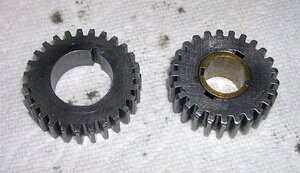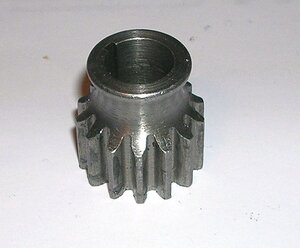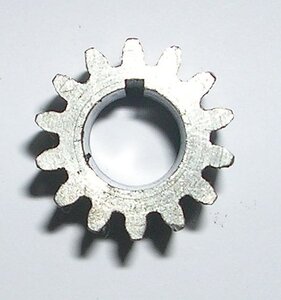-
Spring 2024 meetup in Calgary - date Saturday, April 20/2024. discussion Please RSVP Here to confirm and get your invitation and the location details. RSVP NOW so organizers can plan to get sufficient food etc. It's Tomorrow Saturday! you can still RSVP until I stop checking my phone tomorrow More info and agenda
-
We are having email/registration problems again. Diagnosis is underway. New users sorry if you are having trouble getting registered. We are exploring different options to get registered. Contact the forum via another member or on facebook if you're stuck. Update -> we think it is fixed. Let us know if not.
You are using an out of date browser. It may not display this or other websites correctly.
You should upgrade or use an alternative browser.
You should upgrade or use an alternative browser.
Are gears with the same Diametral Pitch (DP) guranteed to mesh?
- Thread starter YYCHM
- Start date
Are you sure the gear is dp and not metric?
Not sure of anything. Gear is for my made in Ontario Peerless Tool Co. Shaper. It appears to mesh well with the 28 tooth head stock gear on my Utilathe but I never did establish what the parameters are for that one.
Last edited:
How did you arrive at the 16 DP?
The pitch diameter of the gear I have appears to be close to 0.875 so 14/0.875=16. Based on the diameter and tooth count you provided me with, the 28 tooth gear would be 28/1.75=16.
https://www.mcmaster.com/gears/comp...ter~1-75/bore-type~machinable/face-width~1-2/ This seems to match up perfectly with the 1.87" OD you provided me with.
Last edited:
Another approximation is to use: DP=(N+2)/OD. From that it would appear that the gear you have has an OD of ~1” if the DP=16. Can you confirm that?
Gears with same DP should mesh. Based on the age of the shaper, it probably does have gears with 14.5* PA. I think 20* became more popular later as these gears supposedly run quieter.
Since this will be a low speed, low torque application, even if the PAs were different, it should still be fine.
Gears with same DP should mesh. Based on the age of the shaper, it probably does have gears with 14.5* PA. I think 20* became more popular later as these gears supposedly run quieter.
Since this will be a low speed, low torque application, even if the PAs were different, it should still be fine.
Another approximation is to use: DP=(N+2)/OD. From that it would appear that the gear you have has an OD of ~1” if the DP=16. Can you confirm that?
I'm seeing 0.993" so very close to 1.0".
It's interesting that it was a 28 tooth gear I was missing for my Utilathe as well. That one I obtained from a parted out lathe so I never did figure out exactly what it was.
Last edited:
Yes, that would be nominal 1” => close enough.
So yes, if you see a gear on McMaster that is labelled DP = 16, it will mesh properly with your existing one.
If you can’t find a suitable gear online, I can make you a 28T, 16DP, 14.5*PA gear; I just checked, I have the correct involute cutter.
So yes, if you see a gear on McMaster that is labelled DP = 16, it will mesh properly with your existing one.
If you can’t find a suitable gear online, I can make you a 28T, 16DP, 14.5*PA gear; I just checked, I have the correct involute cutter.
Brent H
Ultra Member
Ditto for me @RobinHood
I am looking to buy a set of 20 PA tooth profile gauges so I can verify some gears I would like to make.
The Utilathe is a combination of 20 and 14.5 PA
I am looking to buy a set of 20 PA tooth profile gauges so I can verify some gears I would like to make.
The Utilathe is a combination of 20 and 14.5 PA
These are what I'm replacing.....

They are the power feed drive gears. The driving gear is 27 tooth, 1.45" OD with a 3/4" bore. The driven gear is 25 tooth, 1.346" OD with a 1/2" bore. They are being replaced with a 28 tooth, 1.88" OD gear and a 14 tooth, 1" OD gear.
Quite the discrepancy eh???? That's almost twice the feed rate. I wonder if it was geared down for a reason?
@francist can you comment on this?

They are the power feed drive gears. The driving gear is 27 tooth, 1.45" OD with a 3/4" bore. The driven gear is 25 tooth, 1.346" OD with a 1/2" bore. They are being replaced with a 28 tooth, 1.88" OD gear and a 14 tooth, 1" OD gear.
Quite the discrepancy eh???? That's almost twice the feed rate. I wonder if it was geared down for a reason?
@francist can you comment on this?
Last edited:
Perhaps they came with two sets of gears?
No, what's installed are the wrong gears. The gear depicted in my OP is meant to be moved between the horizontal and vertical feed shafts. The gears installed are the wrong diameter such that the movable gear is captured and you have to disassemble the power feed ratchet mechanism to switch the driven gear between shafts.
francist
Super User
Huh, no idea. If I’m getting this right the existing arrangement presents a lower gear ratio resulting in a slower or smaller increment in the table movement? I don’t know why you would need that unless to lessen the chances of burying a cutter during a cut. I confess I don’t use the vertical feed on my machine, only the horizontal, but I can see if you’re trying to sneak up on something like a keyway depth it’s real easy to have that relatively wide cutting edge grab and bury itself. A smaller increment might make that less likely.can you comment on this?
That’s the only thing I can think of other than pure chance that those gears are the only ones they had on hand and they decided to use them. One looks like it may be an old Atlas change gear, it has the two opposing keyways, but their gears weren’t steel.
-frank
Since this will be a low speed, low torque application, even if the PAs were different, it should still be fine.
If you've tried this and it worked, I bow to your experience, however I'm thinking it would be a problem. For sure a 14.5 or 20 dp gauge shows a significant difference in fit when you try gauging a gear - the correct PA drops in a lot farther than the incorrect. If on a banjo or something it might work but would be rough runnng....if its a fixed distance I'd be betting they wouldn't mesh.
If you can’t find a suitable gear online, I can make you a 28T, 16DP, 14.5*PA gear; I just checked, I have the correct involute cutter.
Can you tell from your cutter and the gear I have if it is in fact 14.5 PA?
I have a gear pitch gage. It is for 14.5* PA. The cutters are labelled with ”14.5* PA”. We could check the little 14T gear you have.
PM sent.
francist
Super User
Interesting. I just took a peek into Machinery’s Handbook because I was rembering they had a full-size layout of a bunch of different gear teeth. They do, but they don’t say what pressure angle they are but in the text on the opposing page it went into why the 20 may be preferred over a 14-1/2 degree angle. One of the most striking reasons was the number of teeth — less than 18 teeth and the undercutting in the tooth form starts to become undesirable, and at 14 teeth is verging on excessive. So, the one small gear on the shaper is 14 teeth — I wonder which pressure angle it will actually measure out at? By the book one might think it should be 20.
-frank
-frank


